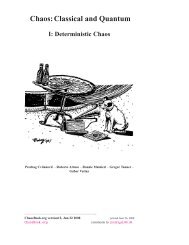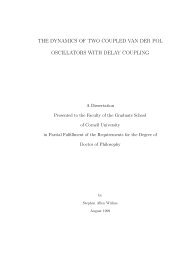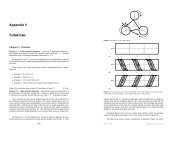Quantum scattering - Chaos: Classical and Quantum
Quantum scattering - Chaos: Classical and Quantum
Quantum scattering - Chaos: Classical and Quantum
Create successful ePaper yourself
Turn your PDF publications into a flip-book with our unique Google optimized e-Paper software.
Exercises<br />
35.1. Spurious orbits under the Krein-Friedel-Lloyd contruction.<br />
Draw examples for the three types of period<br />
orbits under the Krein-Friedel-Lloyd construction: (a)<br />
the genuine periodic orbits of the <strong>scattering</strong> region, (b)<br />
spurious periodic orbits which can be removed by the<br />
subtraction of the reference system, (c) spurious periodic<br />
orbits which cannot be removed by this subtraction.<br />
What is the role of the double limit η → 0, container size<br />
b → ∞?<br />
a<br />
R<br />
a<br />
35.2. The one-disk <strong>scattering</strong> wave function. Derive the<br />
one-disk <strong>scattering</strong> wave function.<br />
(Andreas Wirzba)<br />
35.3. <strong>Quantum</strong> two-disk <strong>scattering</strong>. Compute the quasiclassical<br />
spectral determinant<br />
⎛<br />
∏<br />
Z(ε) = ⎜⎝ 1 −<br />
p, j,l<br />
t p<br />
Λ j+2l<br />
p<br />
⎞<br />
⎟⎠<br />
j+1<br />
for the two disk problem. Use the geometry<br />
The full quantum mechanical version of this problem<br />
can be solved by finding the zeros in k for the determinant<br />
of the matrix<br />
M m,n = δ m,n + (−1)n<br />
2<br />
J m (ka)<br />
H n<br />
(1) (ka)<br />
(<br />
H<br />
(1)<br />
m−n(kR) + (−1) n H (1)<br />
m+n(k<br />
where J n is the nth Bessel function <strong>and</strong> H n<br />
(1) is the Hankel<br />
function of the first kind. Find the zeros of the determinant<br />
closest to the origin by solving det M(k) = 0.<br />
(Hints: note the structure M = I + A to approximate the<br />
determinant; or read <strong>Chaos</strong> 2, 79 (1992))<br />
35.4. Pinball topological index. Upgrade your pinball simulator<br />
so that it computes the topological index for each<br />
orbit it finds.<br />
References<br />
[35.1] W. Thirring, <strong>Quantum</strong> mechanics of atoms <strong>and</strong> molecules, A course in<br />
mathematical physics Vol. 3 (Springer, New York, 1979). (Springer, Wien<br />
1979).<br />
[35.2] A. Messiah, <strong>Quantum</strong> Mechanics, Vol. I (North-Holl<strong>and</strong>, Amsterdam,<br />
1961).<br />
[35.3] M.G. Krein, On the Trace Formula in Perturbation Theory, Mat. Sborn.<br />
(N.S.) 33, 597 (1953) ; Perturbation Determinants <strong>and</strong> Formula for Traces<br />
of Unitary <strong>and</strong> Self-adjoint Operators, Sov. Math.-Dokl. 3, 707 (1962).<br />
[35.4] M.Sh. Birman <strong>and</strong> M.G. Krein, On the Theory of Wave Operators <strong>and</strong><br />
Scattering Operators, Sov. Math.-Dokl. 3, 740 (1962); M.Sh. Birman <strong>and</strong><br />
D.R. Yafaev, St. Petersburg Math. J. 4, 833 (1993).<br />
[35.5] E. Beth <strong>and</strong> G.E. Uhlenbeck, Physica 4, 915 (1937).<br />
refsScatter - 11aug2005 <strong>Chaos</strong>Book.org version13, Dec 31 2009









